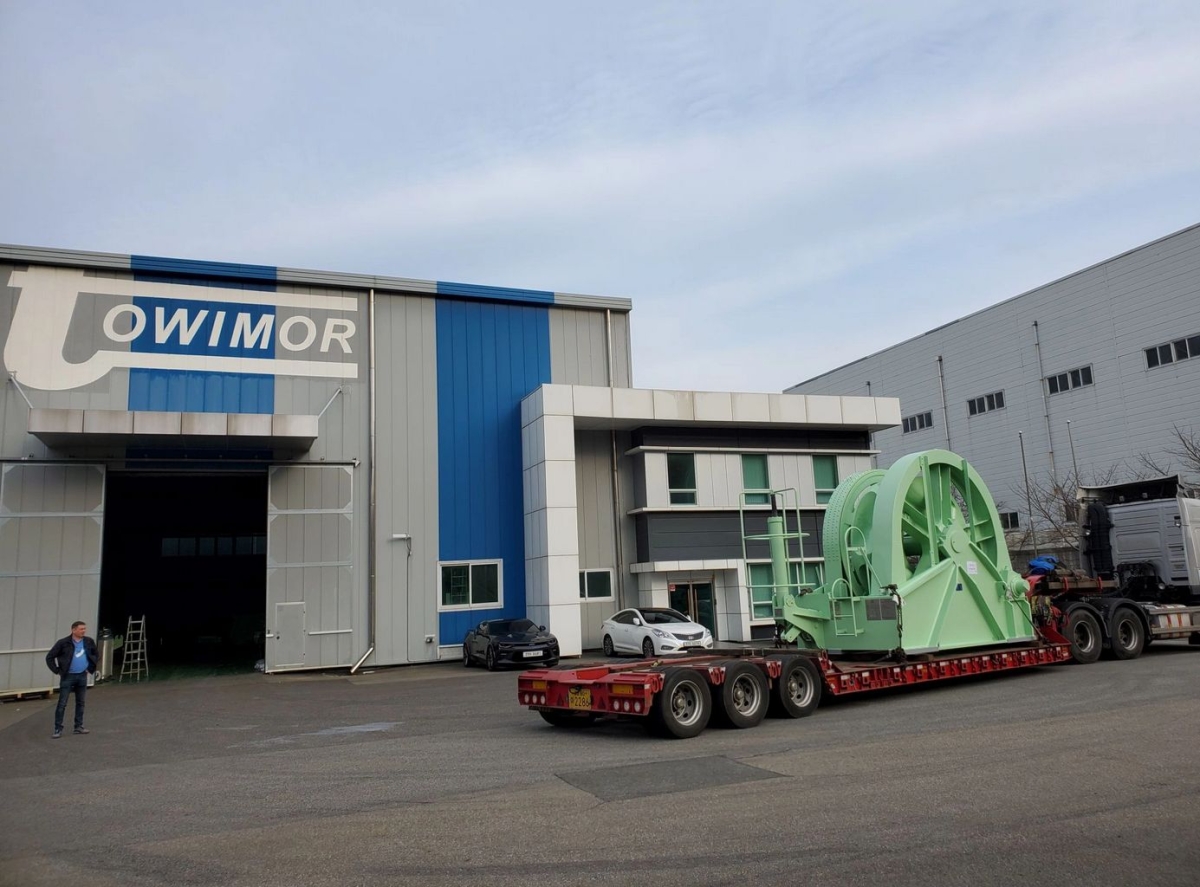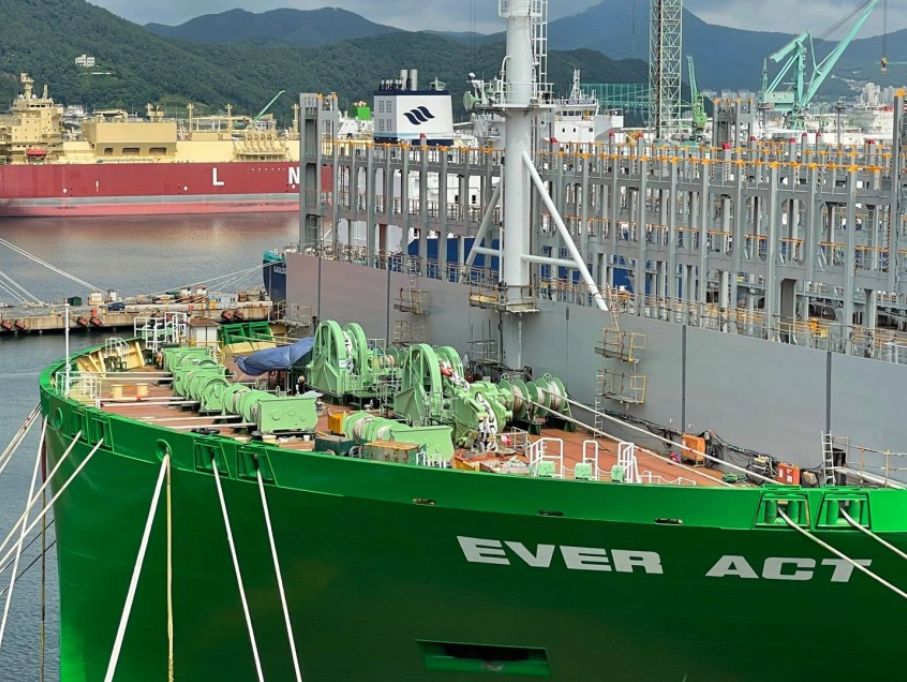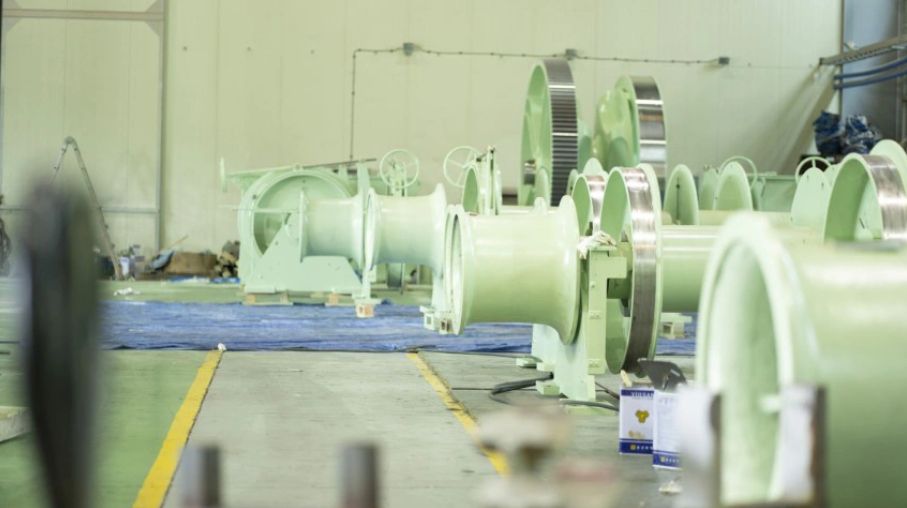
Specializing
in on-board equipment, Towimor is a specific company - as one of the
few on the Polish shipbuilding market, it is not located by the sea,
but in Toruń. But with the creation of factory in South Korea, it is
closer to the customer than ever before. Marcin Starybrat, commercial
director at Towimor, talks about the company's achievements and
plans, as well as the recent years rich in experience.
Towimor
is one of the few companies in the Polish maritime industry whose
headquarters are not located by the sea, but in Toruń. You also have
your plant in South Korea, which probably helps you gain customers
there and operate on the vibrant Asian market.
Our
Korean history has been going on for 10 years. We founded the Korean
company in 2013. It is a company with 100% Polish capital, with its
own factory, partly Polish team, fully functioning, located in the
center of the Korean shipbuilding industry, i.e. in Busan.
Korea
is a huge shipbuilding market. There are a lot of your clients there.
This
was one of the reasons that decided to locate in Busan. Maybe it
wasn't a requirement from the main customers, i.e. shipyards located
around Busan - Samsung, Hyundai and Daewoo - but it was a soft
criterion. It was clear to us that if we were there, at hand, the
client would be able to tangibly verify what we do on a daily basis,
then our chances of contracting would be greater. And indeed, what
happened next was in line with these expectations. Since we moved
there, our order book has grown significantly.
Is
Towimor now one of the leaders on its market, or it is not yet on
that level?
The
word "leader" is too big. It also depends on the segment,
because the shipbuilding market within our product is quite wide. It
would seem that mooring and anchor devices are a simple, uniform,
repeatable product. In reality there are plenty of these devices out
there. The main distinguishing criterion by which we can say whether
we are a leader or not is the type of drive. We specialize in
electric drives. In the case of electric mooring and anchoring
devices in certain shipyards, such as Samsung, we are a leader. If we
narrow down the spectrum of products strictly to mega-containers,
this market generates the majority of orders that we
acquire.
Considering the entire Polish shipbuilding
industry and its peripheries, your products operate on the largest
vessels, which are the most talked about. Are you the most
recognizable Polish shipbuilding brand?
This
is largely determined by the size of the vessels. Large container
ships are very popular in the media, all shipowners have recently
been outdoing each other trying to build bigger and bigger. Just a
few years ago, the limit was 20,000. TEU, today 24,000 are being
built, some already reach 25,000. We follow this trend. Each
subsequent size of ships is our target, which we achieve quite
easily, because many of the largest ships are equipped by Towimor.

Is it easy for you to create a product for these ever-growing container ships?
Increasingly
growing products, resulting from the fact that ships are growing,
have determined some changes in the process of our entire production
chain. In recent years, this size aspect, in parallel with the cost
aspect, has forced us to relocate part of the production from the
Polish plant to the Korean one. As of today, all steel components for
our devices are manufactured in the Korean plant. The production of
electric and hydraulic drives for these devices remained in Poland.
Winches and their components were getting bigger and bigger, they
stopped fitting into containers, which caused huge logistic problems
and costs. Devices of this size were difficult to transport both by
sea and by land. Therefore, the closer it is to the end customer, the
easier, cheaper and faster it is. Hence the decision to move
production to a large extent to the place where we are a stone's
throw from the client, i.e. to Korean Busan. The decision seems
right. Today we are more flexible, it is easier for us, cash flow has
also improved, because the time of delivery by sea extends this
process.
What about other markets? There are large
shipyards in Korea, but the production of ships does not end there.
Do you also have orders from other parts of the world? I am also
asking this in the context of the offshore market, which produces
more and more vessels.
Geographically,
roughly 90% of the shipbuilding industry is concentrated in three
countries, with a large majority in two – South Korea, China and
then Japan. Our main market has been Korea for many years, the number
two market for the same products is China, although from our
perspective, their local market has changed dramatically since the
pandemic. We know that there was a "zero Covid" policy,
which resulted in the fact that our ability to control the production
process, launches and deliveries was very limited. It was felt not
only by Towimor, but by all who function there. As a result, today it
can be said that China shot itself in the foot, because many
shipowners were scared of such an approach and the lack of control
over ship production. Even if they had investment plans for the next
ones, they relocated production. South Korea has become the biggest
beneficiary of this situation. China today is not the same country,
even though the covid policy has relaxed. The market has changed
dramatically in terms of costs, production costs have increased
significantly. In some cases, they are even comparable to European
ones, which, in our opinion, offers good prospects for European,
including Polish shipyards, because part of this production will
certainly return. To what extent and when - it is not known, the
Chinese market is still subsidized by the local government, but the
doors for the European market will certainly open again, especially
in the case of specialized vessels, which will be built a lot in the
near future. We are talking here about ships for the construction of
wind farms or floating LNG reloading terminals. We have recently
acquired orders for this type of vessels, which - as we believe -
will allow us to partly return to Europe with our activity. We've
been less here lately. Most of the orders were from Asia, so we were
more active there. But that should change in the coming years.
So
what about Polish shipyards? Collaboration is flourishing?
The
Polish market is still interesting. We have big limitations in this
market due to the size of the devices that we make. The scale of our
products is suitable for large vessels, we do not support small ones,
because we simply do not have such products. We would have to design
them from scratch, which puts us in a non-competitive
position.
Speaking of large vessels, what dimensions
you have in mind?
It
is more determined by most of the devices that are mounted on them,
but these are ships over 100 meters. We have devices designed for
such ships. There are actually two shipyards in Poland that produce
this type of ships: Remontowa and Crist. These are shipyards with
which we actively cooperate and are invariably one of our main
clients.
Will you participate in the program of
building Polish ferries?
No.
The contract was won by another supplier from outside the country.
However, we are trying to participate in the Miecznik project.
The aforementioned Crist is also working on offshore vessels. This sector is born in Poland and it seems that in the coming years this market will occupy a lot of the maritime industry's time. With this expected return of production to Europe, could offshore be an important part of your order book, or does it not look like it will change anything in the next 7-10 years?
It
seems to us that this market will grow strongly, so it remains in the
sphere of our interest. Crist is one of our main partners. We have
already made such vessels together. Now we also know that the same
shipyard is in talks about the next ones, and we are also actively
participating in the preparatory process for these constructions. We
are interested in offshore. We have good references for this market,
whether thanks to projects implemented together with Crist or with
shipyards from South Korea. The only problem is that these units are
not built very often. I can't imagine that you could make a living
only from this type of projects, because only a few of them are
created in the world every year. There are more and more orders, but
when you look at the shipyard's contract portfolio, these are still
countable, single projects. Even if they are not 1 or 2, but 5 or 7
per year, with a dozen or so suppliers of on-board equipment, each of
them can statistically acquire only one or two ships per year for
servicing. Therefore, it is one of the products we would like to
provide, but not the only one. We need to obtain orders from other
areas of the market to survive on it.

What is your
top product at the moment? Which of your services are most valued by
customers?
In
my opinion, our successes in recent years are due to certain
solutions that we have proposed. First of all, these are drive
backups. When something breaks down in the winch or our other device,
for example, the inverter burns out or another element stops
functioning for some reason, you can smoothly switch to the power
supply of another device, which further ensures the smooth
functioning and safety of the vessel. This is a unique solution that
customers appreciate. This is the main criterion that distinguishes
us on the market and allowed us to obtain such a portfolio of orders.
The
second solution is the advanced technology of remote management of
our devices. The shipowner or decision maker can monitor their work
online from the desk. He knows whether the master uses them in
accordance with the manufacturer's recommendations or uses the
ordered functionalities. It is often the case that shipowners order
very whimsical solutions, which are then not used because the crews
cannot or do not need it. The functionality we proposed gives the
person who paid for the device the opportunity to check whether
something is used or not, whether further orders should be developed
in this direction, or whether it will not be needed.
Another
unique solution in the field of hydraulic drives are arctic projects.
Last year we set ourselves the task of developing this segment,
because it is quite unique on the market. We are currently
implementing devices that will be adapted to work at a temperature of
-58 degrees Celsius, which is a sensation and, to my knowledge, no
one other than Towimor offers such solutions in the field of
hydraulic drives.
The best customer for such
solutions would be Russia, but it is impossible to trade with them
now.
I
must admit that it was designed for this market, despite the fact
that Russian orders from the Korean market were canceled, and it was
the Koreans who obtained orders for Arctic ships for Russia. We know
what happened after Russia attacked Ukraine. All orders have been put
on hold, but that hasn't stopped the work we've begun. We have
finished it, we have a project, we assume that there are other
potential customers outside of Russia, thanks to whom we will be able
to commercialize this project in the near future.
Are there other innovative projects on Towimor's drawing boards that have a chance of being implemented?
There
are many such development projects, but the main limitation is
construction resources, and we usually face the challenge of dividing
them between handling current projects and developing new products.
And due to the fact that this portfolio of orders has recently filled
up - we have 50 ships to handle for this and next year - we simply
lack time.
So how to solve this problem?
Experienced
people would be best. We're not the only ones with this problem. In
addition, we are not located by the sea, so there are few people from
the industry here. All those who are in our design office and know
the specifics of the product are Towimor's pupils.
You
mentioned Towimor's successes in recent years. Let's sum up - what
worked, what didn't work, what were the most important turning points
for the company recently?
The
first turning point is around 2003 and entering the Korean market. It
was the moment when the Polish shipbuilding industry had the biggest
problems, the shipyards went bankrupt one by one. The milestone was
that we managed to smoothly jump to the next market and the company
not only did not suffer from it, but also gained.
Another
important point is 2013 and the Korean factory. He gave us a mega
kick and brought us closer to this market. We began to be perceived
as a local supplier, not someone from outside, and hence who you can
come and see what we are doing by yourself.
The
third milestone is the last years of 2021-22 and the reorganization
of the production process. The cost situation and the logistics
aspect, as we discussed earlier, reorganized Towimor and shifted the
production burden to Asia. We have shrunk our workforce in Poland,
there are fewer of us, we focus locally on engineers, constructors,
the sales and service department, and the development of the drives
production industry. These are the three most important changes of
the last twenty years.
Now about the future - what
awaits Towimor in the coming months?
We
have quite well-defined plans for the next two years. The enormity of
orders that we have to fulfill are volumes that have never been there
before. We have a lot of projects to do. Therefore, we will focus on
fulfilling our orders on time. We also want to develop new market
sectors, such as the aforementioned specialized vessels for erecting
wind turbines and servicing LNG terminals. We are close to obtaining
an order from Samsung, which is building a ZLNG unit for Petronas - a
floating transshipment terminal for handling LNG ships. It''s not a
secret that we also believe in Crist's successes in this market
segment and our potential share in them - the more so that we have
just increased our references in WTIV (Wind Turbine Installation
Vessels) vessels by implementing a contract in Korean Daewoo for the
Monegasque shipowner Eneti. We entered the current year with a new
order from the container ship market. Six large container ships of
8,000 tons each TEU for French CMA produced in Hyundai.
We are
also waiting for greater logistic activity. The world has opened up
again, it's time to move again. For the last two years, we've rather
worked from behind a desk, like most people in the industry. There
was no possibility to travel to Asia, mainly to China. This market is
opening up again, so we're sure to see more activity.


